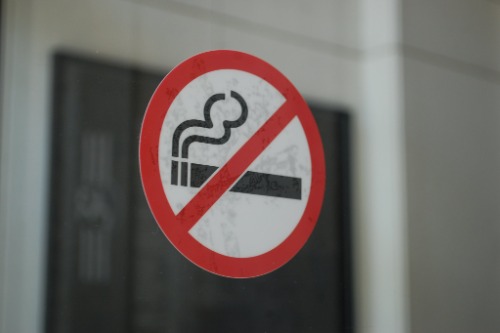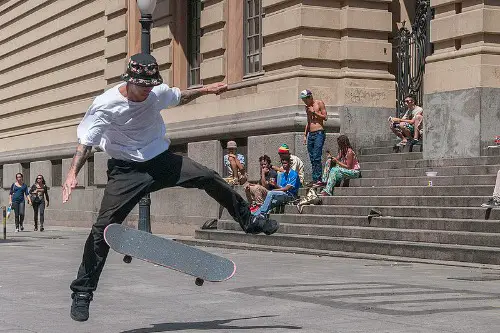1. School Bus Stop Arm Cameras – Connecticut

In 2009, a Connecticut dad was furious after seeing a car blow past his child’s school bus while the stop arm was extended. He reported the plate to police, but nothing came of it. Frustrated by how hard it was to enforce bus stop laws, he campaigned for bus-mounted cameras that could automatically ticket violators. Thanks to his efforts, Connecticut passed a law allowing and funding the installation of stop-arm cameras.
Now, when a car illegally passes a bus, the camera records it, and a ticket is mailed — similar to a red-light camera, according to the National Conference of State Legislatures. It’s helped reduce violations and improve child safety during pickup and drop-off times. All because one dad decided a close call wasn’t something he could ignore. The law has since been copied by other states facing the same problem.
2. No Parking in Front of Your Own Driveway – New York City, NY

You’d think you’d be allowed to park in front of your own driveway — but not in New York City, and it’s largely because one neighbor wouldn’t let it go. In the early 2000s, a Brooklyn man repeatedly called the city about his neighbor parking in front of his own curb cut. He claimed it made it harder for others to back out and created confusion about who could park there. Eventually, his persistence led the city to clarify and enforce a law that prohibits anyone from parking in front of a driveway — even the homeowner.
The logic is that emergency vehicles and city services need clear access at all times, according to New York Parking Ticket. So even if it’s “your” driveway, blocking it is still a violation. It’s a classic case of one complaint turning into citywide policy. And in a place where parking is gold, it still sparks debates to this day.
3. Dog Barking Time Limits – Los Angeles, CA

In the early 2000s, a woman in LA’s Fairfax District launched a campaign after she couldn’t sleep due to her neighbor’s barking dog. She logged every bark, sent dozens of letters, and showed up to city meetings armed with audio recordings. Her efforts paid off: Los Angeles created an ordinance stating that a dog cannot bark continuously for more than 30 minutes or intermittently for 60 minutes within 24 hours, according to Hannah Fry from The Los Angeles Times.
The law helped give animal control a clearer standard for acting on noise complaints. Before that, “nuisance barking” was too subjective to enforce consistently. Thanks to one sleep-deprived resident, LA now has one of the most specific anti-barking laws in the country. And yes — it’s still used, especially in tight neighborhoods where sound carries.
4. No Smoking in Cars with Kids – Arkansas

In 2006, a grandmother in Arkansas started a public campaign after witnessing a toddler coughing in the back seat of a smoke-filled car. She had lost a relative to childhood asthma and was determined to protect other kids from secondhand smoke. She contacted lawmakers, showed up at town halls, and wouldn’t take no for an answer. Her push directly led to Arkansas becoming the first southern state to ban smoking in cars when minors are present.
The law now makes it a misdemeanor to smoke in any vehicle with a child under 14, according to FindLaw. Other states followed suit, but it all started with one person’s personal crusade. It’s a good example of how grassroots efforts can lead to real legislative change. Today, it’s widely seen as common sense — but it began with a single complaint.
5. Ban on Feeding Stray Cats – Omaha, Nebraska

In the late 2000s, a man in Omaha got tired of the growing number of stray cats congregating in his yard. He traced the problem to a neighbor who left out food daily, which caused the stray population to boom. After months of calling the city and pushing officials to take action, a new ordinance was introduced restricting the feeding of unowned cats in public or unfenced areas, according to Eric Forrest from Pets in Omaha.
Animal control supported the law, arguing that feeding strays without also managing their health and reproduction worsened the problem. Opponents said it punished compassion, but the city stuck by it. All of it began with one annoyed resident who didn’t want his flower beds turning into a cat hangout. The rule still stands, and the city now partners with TNR (Trap-Neuter-Return) groups to manage stray colonies more humanely.
6. No After-Hours Helicopter Flights – Los Angeles, CA

Noise from low-flying helicopters became a huge nuisance in some LA neighborhoods, especially during celebrity home chases or breaking news coverage. But it wasn’t until one homeowner near Mulholland Drive documented dozens of late-night flights that Congress actually paid attention. He filed FAA complaints, circulated petitions, and worked with his local representative to push for regulation. The result was a 2014 federal law directing the FAA to develop guidelines to reduce nonessential helicopter noise in LA County.
While it’s not a blanket ban, the law pushed for voluntary curfews and routing changes that reduced disturbances. The FAA also set up a complaint hotline to track problem flights. All of it stemmed from one guy who just wanted to sleep through the night. His noise logbooks helped launch a broader conversation about aviation and urban livability.
7. Fence Height Restrictions – San Diego, CA

In 1996, a woman in San Diego filed a zoning complaint after her new neighbor put up an 8-foot privacy fence that blocked her view and sunlight. She argued that it violated the “character” of the neighborhood and made her yard feel like a prison. She took it to the city council, showed photos, and rallied nearby homeowners. Her complaint led to a citywide rule capping backyard fence heights at 6 feet without a special permit.
The city agreed that overly tall fences could affect neighbors’ quality of life, light access, and property values. Exceptions could still be made, but the default rule was changed thanks to her push. It’s a great example of how seemingly small issues — like a tall fence — can turn into big policy changes. And yes, the neighbor was not happy about it.
8. No Sale of Alcohol on Sundays – Maine

In the 1950s, a Maine resident filed a formal complaint to the state government, arguing that stores selling alcohol on Sundays were disrupting family time and causing public disturbances. The state took the complaint seriously, eventually passing a law that restricted the sale of alcohol on Sundays. This law was heavily influenced by the belief that Sunday should remain a day of rest and family activities. While the law has since been relaxed in many places, it remains in effect in some parts of the state, all thanks to one person’s push for a quieter Sunday.
For decades, the “blue laws” limiting Sunday sales were commonplace across much of New England. The Maine law was initially intended to prevent social unrest and uphold religious observance. It’s another example of how one person’s dissatisfaction with a particular societal trend can lead to a ripple effect in legislative action. Maine’s law still stands, although many states have since loosened restrictions on Sunday alcohol sales.
9. No Washing Your Car on the Street – New York City, NY

In 2010, a New York City resident launched a complaint against her neighbor who regularly washed his car in front of his apartment, creating a mess with soap, water, and runoff. She argued it was both unsightly and contributed to pollution, as the soap would drain directly into the streets. After filing a formal complaint, the city responded by passing a law that restricted car washing on public streets to preserve water quality and reduce waste. The regulation now states that vehicles must be washed in designated areas or private property, not on public sidewalks or streets.
While it seems minor, this law is an important part of the city’s ongoing efforts to curb pollution and keep urban spaces clean. This ordinance was put into place to preserve the aesthetic and environmental integrity of the area. It was born from a single complaint but has since become part of NYC’s broader approach to public cleanliness. Now, those who want to wash their cars have to do it in a way that doesn’t affect others or the environment.
10. No Spitting on Sidewalks – New York City, NY

In the early 2000s, a business owner in New York City complained about the constant spitting on sidewalks near his restaurant. He argued that it was unsanitary and unappealing, especially given the heavy foot traffic in the area. His complaint gained traction, leading to the passing of a regulation that prohibited spitting in public places in the city. Though it might seem like an obvious rule, it wasn’t formally enforced until this complaint pushed it into the spotlight.
The law is part of the broader efforts to make NYC more pleasant for residents and tourists alike. This is one of those simple yet impactful rules that often goes unnoticed, but it helps maintain public hygiene. One man’s frustration with spitting — which seemed small but was widespread in certain areas — turned into an official, citywide regulation. It’s a great example of how even the smallest concerns can lead to real changes when people speak up.
11. No Fireworks Without a Permit – Michigan

In the early 1990s, a Michigan resident living near a popular Fourth of July fireworks spot made a formal complaint after being disturbed by loud, unpermitted fireworks in the weeks leading up to the holiday. The fireworks were happening randomly, without notice, and were scaring her pets and disrupting her peace. Her complaint sparked a citywide review of fireworks laws, leading to a new ordinance requiring permits for any public or private fireworks display. The new regulation made it illegal to shoot off fireworks without a permit, regardless of the time of year.
This law was put in place to prevent the safety hazards and disturbances caused by unsupervised fireworks. It also allowed for better planning and enforcement, as the city could issue fines to violators. This was a direct result of a single person’s action to improve their quality of life. What started as a neighborhood nuisance turned into a law that many other states and cities now adopt, especially around major holidays.
12. No Selling of Fruit Without a License – California

In the 1980s, a resident living in a residential area of Los Angeles complained to the city about the proliferation of fruit stands run by unlicensed vendors. The vendors, often selling fresh produce from their backyards, were seen as disrupting the neighborhood’s safety and cleanliness. After gathering enough complaints, the city passed an ordinance requiring all individuals to obtain a permit to sell fruit or produce within city limits. The law was designed to regulate street vending and ensure that it met health and safety standards.
While the rule was intended to ensure food safety and avoid unsanitary practices, it also limited the freedoms of local, informal vendors. However, it was a direct response to one person’s concern about the public health risks of unsupervised street sales. Today, this law continues to shape the way vendors operate in California’s busy urban environments. What seemed like an inconvenience to a few residents turned into a widespread regulatory change.
13. No Skateboarding in Public Parks – San Francisco, CA

In the late 1970s, a group of skateboarders began using a popular park in San Francisco for tricks and stunts, much to the frustration of nearby residents who felt the park was no longer a peaceful place. One local resident, an older man, filed several complaints to the city council, arguing that skateboarding was dangerous and ruining the park for families. The city took his complaints seriously and soon passed an ordinance prohibiting skateboarding in certain public areas, including parks. The law was introduced as a safety measure, aiming to balance the needs of various park-goers.
Although the law restricted skateboarding in certain areas, it did not completely ban the activity. Over time, skateboarders advocated for dedicated skate parks, and today, many cities have built skateboarding-friendly spaces. Still, this law remains a reminder that public space usage is often influenced by complaints from residents seeking safety or a more peaceful environment. The law, though controversial, originated from a single complaint about safety and order in public parks.


